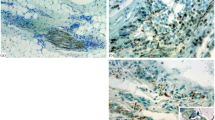Synopsis
Carotid bodies of adult albino rats were examined using the formaldehyde-induced fluorescence (FIF) method for the demonstration of fluorogenic monaomines and staining with I% Toluidine Blue for morphological observations.
In the carotid body of normal controls, most glomus (principal or type I) cells exhibited a FIF presumably due to catecholamines. The intensity of the fluorescence was weak in most cells, while some glomus cells were non-fluorescent and others exhibited a moderate or intense FIF. The sustentacular (satellite, supporting or type II) cells were essentially non-fluorescent.
One week after the administration of a single intraperitoneal injection of the long-acting glucocorticoid 6-methylprednisolone sypionate (400 mg/kg) or after seven intraperitoneal injections of the water-soluble glucocorticoid hydrocortisone sodium succinate (40 mg/kg daily for a week), a distinct increase was observed in the FIF of the glomus cells. No non-fluorescent glomus cells were observed after treatment with either glucocorticoid, and the intensity of most fluorescent glomus cells was moderate or intense.
It is concluded that glucocorticoids cause an increased storage of catecholamines in the glomus cells of the carotid body of the adult rat, an observation of interest in view of the fact that such changes due to glucocorticoids have as yet been reported only in catecholamine-storing cells of newborn rats.
Similar content being viewed by others
References
Biscoe, T. J. (1971). Carotid body: structure and function.Physiol. Rev. 51, 437–95.
Eränkö, L. (1972). Histochemical and electron microscopical observations on catecholamines in developing sympathetic ganglion.Acta inst. anat., (Helsinki), Suppl. 5, 1–30.
Eränkö, O. &Eränkö, O. (1972). Effect of hydrocortisone on histochemically demonstrable catecholamines in the sympathetic ganglia and extra-adrenal chromaffin tissue of the rat.Acta physiol. scand. 84, 125–33.
Eränkö, O. (1967). The practical histochemical dmonstration of catecholamines by formaldehyde-induced fluorescence.J. R. microsc Soc. 87, 259–76.
Eränkö, O. &Eränkö, L. (1971). Small, intensely fluorescent granule-containing cells in the sympathetic ganglion of the rat.Prog. Brain Res. 34, 39–51.
Eränkö, O., Heath, J. &Eränkö, L. (1973). Effect of hydrocortisone on the ultrastructure of the small, granule-containing cells in the superior cervical ganglion of the newborn rat.Experientia 29, 457–9.
Eränkö, O. &Härkönen, M. (1963). Histochemical demonstration of fluorogenic amines in the cytoplasm of sympathetic ganglion cells of the rat.Acta physiol. scand. 58, 285–6.
Eränkö, O. &Härkönen, M. (1965). Monoamine-containing small cells in the superior cervical ganglion of the rat and an organ composed of them.Acta physiol. scand. 63, 511–12.
Hervonen, A. &Kanerva, L. (1972). Cell types of human fetal superior cervical ganglion.Z. Anat. Entw.-Gesch. 137, 257–69.
Hervonen, A., Kanerva, L., Korkala, O. &Partanen, S. (1972). Effects of hypoxia and glucocorticoids on the histochemically demonstrable catecholamines of the newborn rat carotid body.Acta physiol. scand. 86, 109–44.
Hervonen, A. &Korkala, O. (1972). Fine structure of the carotid body of the midterm human fetus.Z. Anat. Entw.-Gesch. 138, 135–44.
Kanerva, L. (1972). Development, histochemistry and connections of the paracervical (Frankenhüser) ganglion of the rat. A light and electron microscopic study.Acta inst. anat. (Helsinki), Suppl. 2.
Lempinen, M. (1964). Extra-adrenal chromaffin tissue of the rat and the effect of cortical hormones on it.Acta physiol. scand. 62, Suppl. 231, 1–91.
Matthews, M. R. &Raisman, G. (1969). The ultrastructure and somatic efferent synapses of small granule-containing cells in the superior cervical ganglion.J. Anat. (Lond.) 105, 255–82.
Pearse, A. G. E., Polak, J. M., Rost, F. W. D., Fontaine, J., Lelievre, C. &Ledouarin, N. (1973). Demonstration of the neural crest origin of type I (APUD) cells in the avian carotid body, using a cytochemical marker system.Histochemie 34, 191–203.
Ploem, J. S. (1971). The microscopic differentiation of colour of formaldehyde-induced fluorescence.Prog. Brain Res. 34, 27–38.
Zapata, P., Hess, A., Bliss, E. L. &Eyzaguirre, C. (1969). Chemical, electron microscopic and physiological observations on the role of catecholamines in the carotid body.Brain Res. 14, 473–96.
Yates, R. D., Cheni-Li &Duncan, D. (1970). Effects of sinus nerve stimulation on carotid body glomus cells.J. Cell Biol. 46, 544–52.
Author information
Authors and Affiliations
Rights and permissions
About this article
Cite this article
Korkala, O., Eränkö, O., Partanen, S. et al. Histochemically demonstrable increase in the catecholamine content of the carotid body in adult rats treated with methylprednisolone or hydrocortisone. Histochem J 5, 479–485 (1973). https://doi.org/10.1007/BF01012005
Received:
Issue Date:
DOI: https://doi.org/10.1007/BF01012005



